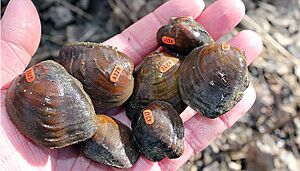Catspaw facts for kids
Quick facts for kids Catspaw |
|
|---|---|
 |
|
| Conservation status | |
| Scientific classification | |
| Genus: |
Epioblasma
|
| Species: |
obliquata
|
| Synonyms | |
|
|
The catspaw mussel (scientific name: Epioblasma obliquata) is a special type of freshwater mussel. It lives in rivers and streams in eastern North America. Sadly, it is an endangered species. This means it is at high risk of disappearing forever.
There are two main kinds, or subspecies, of the catspaw mussel. Each one looks a bit different. Because these mussels are so rare, scientists do not know much about their specific behaviors. They only know what is common for most freshwater mussels.
Contents
Catspaw Mussel: Life and Survival
The catspaw mussel used to live in many places. It was found across the Ohio River and Great Lakes areas. These mussels like to live in shallow, rocky parts of big rivers. These spots are called riffle zones. They have lots of oxygen, which mussels need to breathe.
Why Catspaw Mussels Are Disappearing
Over the last 200 years, many of these important homes have been destroyed. This happened because people built dams and dug up riverbeds (called dredging). These actions changed the rivers a lot. This caused the number of catspaw mussels to drop very quickly.
Other big dangers for freshwater mussels include changes in water temperature. Also, changes in how fast the water flows and how cloudy the water is (called turbidity) hurt them. These changes make it very hard for mussels to survive. They affect how mussels live and how they find food.
Saving the Catspaw: Conservation Efforts
Both types of catspaw mussels are in serious danger. They are called the white catspaw and the purple catspaw.
The Purple Catspaw's Story
The purple catspaw (Epioblasma obliquata obliquata) was listed as endangered in 1990. At that time, scientists thought there were no breeding groups left. But in 1994, a few young mussels were found in Killbuck Creek in Ohio. This was exciting news! It meant a small group was still breeding.
Scientists tried to collect young mussels to start a breeding program. This would help them raise mussels safely. But in 2006–2007, surveys found only 12 male mussels and no females. This was disappointing. It was not until 2012 that scientists found the first female mussels. Now, captive breeding programs are finally underway. This gives hope for the purple catspaw.
The White Catspaw's Story
The white catspaw (Epioblasma obliquata perobliqua) is in even greater danger. Only one group has been found in modern times. This group lives in Fish Creek, a river that flows into the St. Joseph River in Indiana.
From 1975 to 1999, only five living white catspaw mussels were found there. The last living female was seen in 1975. Since then, scientists have not found any living white catspaw mussels in Fish Creek. This means they might be gone from that area.
Understanding Catspaw Mussel Types
Scientists have studied the catspaw mussel's shell features. They used to think these mussels were just different types of the same species. But now, they are often seen as separate species.
The U.S. Fish and Wildlife Service, along with other experts, has separated them. This is based on their family tree (phylogeny), shell looks, and where they live. Both are now protected as endangered species.
- Purple catspaw (Epioblasma obliquata obliquata): Now officially called Epioblasma obliquata.
- White catspaw (Epioblasma obliquata perobliqua): Now officially called Epioblasma perobliqua.
What Catspaw Mussels Look Like
The two types of catspaw mussels have different looks. They even look different between males and females!
White Catspaw Appearance
The white catspaw has different shell shapes for males and females.
- Males have shells that are more oval-shaped. Their shell grooves are deeper.
- Females have shells that look more like a rectangle.
The outside of their shell is a tan color. The inside is shiny and pearly white. These mussels are usually about 2 inches long.
Purple Catspaw Appearance
The purple catspaw has a shell that is yellow, green, or brownish on the outside. The inside is a beautiful deep purple color. This type also shows differences between males and females.
- Males have narrower shells.
- Females have wider shells.
Male purple catspaws can grow up to 70 millimeters (about 2.7 inches).
Catspaw Mussel Behavior
Because these mussels are so rare, scientists do not know much about their daily lives. For example, they do not know when they reproduce. They also do not know how they grow or how long they live.
We do know that catspaw mussels are filter feeders. This means they eat tiny bits of food floating in the water. They filter the water through their bodies to get their food.
More basic research is needed on the catspaw mussel. This will help scientists understand them better. It is important if we hope to bring them back to their old homes.
Images for kids




